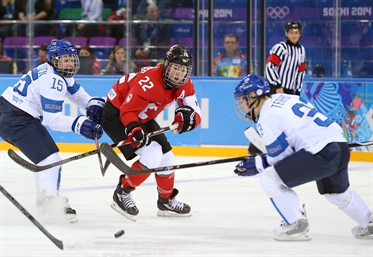Canada’s women adapt
Canada’s women adapt
A different kind of team, but the W’s continue

 SOCHI, RUSSIA - FEBRUARY 10: Canada's Haley Wickenheiser #22 skates with the puck against Finland's Minttu Tumominen #15 and Emma Terho #3 during women's preliminary round action at the Sochi 2014 Olympic Winter Games. (Photo by Andre Ringuette/HHOF-IIHF Images)
SOCHI, RUSSIA - FEBRUARY 10: Canada's Haley Wickenheiser #22 skates with the puck against Finland's Minttu Tumominen #15 and Emma Terho #3 during women's preliminary round action at the Sochi 2014 Olympic Winter Games. (Photo by Andre Ringuette/HHOF-IIHF Images)
It seems, though, that Canada has adapted its game to meet the challenges of 2014, and it has done so with remarkable success.
In the past, Canada routinely scored goals in the double digits against their European opponents. The team even reached 18-0 against Slovakia in 2010 and 16-0 against host Italy in 2006.
This year, however, the team has just eleven goals in three games, an average of fewer than four per game. The team’s leading goalscorer is Meghan Agosta with “only” three, and the leading point-getters are Agosta and Rebecca Johnston with “only” four (two goals, two assists). Yet the team has surrendered only two goals and is, as always, a perfect 3-0 heading into the semi-finals against the Swiss, a team they have never lost to and outscored 65-1 in seven games.
What is impressive is that despite the new coach at the eleventh hour, despite the captain change just before the Games started, Canada has proved resilient. Here’s how the success has continued to the point that the team has won 18 consecutive Olympic games going back to day one of 2002.
Goaltending
Shannon Szabados doesn’t get tested as often as the Europeans, but she is letter perfect. Her play was key to victory in Vancouver in 2010, and she was strong when she had to be against Finland last week in Sochi. Even if teams manage to penetrate deep into Canada’s end, they have a near-impossible task of beating a goalie who is the best there is.
Defence
Is it possible for the team’s defence to be under-rated? The attack has been so consistently impressive one forgets the talent at the back end. Catherine Ward and Laura Fortino anchor a blue line that is virtually impenetrable. They move quickly, get the puck up ice with precision, and protect their goalie with a resolve that is nothing if not formidable.
Forwards
Let’s face it, Canada isn’t going to win any more as a result of Hayley Wickenheiser controlling the game. Compare the game today to when she started in 1994—girls are bigger, faster, stronger. “Wick” doesn’t dominate, but she can still contribute.
Agosta and Marie-Philip Poulin are the stars up front, but they are not in the same category of sheer offensive output as Wickenheiser because the game has changed. Think Gretzky-Crosby comparison. Great, but different.
But what the team lacks in sheer goal-scoring ability it makes up for in details. Three of the top 12 players in faceoff percentage, for instance, are Poulin and Wickenheiser who are also tied for second with 40 faceoff wins. Get the faceoff, gain possession—advantage Canada.
As well, the team is as strong as it’s ever been in puck pursuit, taking away time for the opposition to think or create, forcing turnovers and using the full ice to counter-attack. Canada has been keeping its game plan simple. Nothing fancy, no mistakes. Make the safe play not the great play.
When you put all the pieces together, this Team Canada is different from previous editions, but there remains one constant—the numbers in the W column keep going up, and the number in the L column remains the same—zero.
Back to Overview







































